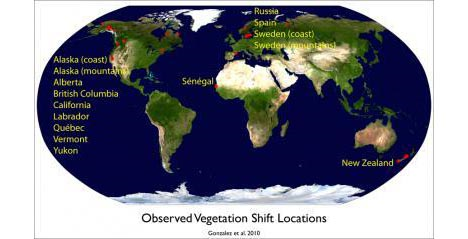Climate change already pushing vegetation toward poles and equator
By Matthew McDermott, New York, NY on 06. 9.10
Science & Technology (science) Vegetation around the globe has already been moving in response to global climate change, a new report in the journal Global Ecology and Biogeography shows. In fact the report authors say that since the 18th century they have found fifteen cases where biomes have shifted because of temperature and precipitation changes (see map)–vegetation has moved up mountainsides towards cooler temperatures and to the equator where there is more precipitation. Climatic changes were found to be of greater importance than direct human activity. All of this is only set to increase with further warming.An estimated one-tenth to one-half of the land mass on Earth will be highly vulnerable to climate-related vegetation shifts by the end of this century, depending upon how effectively humans are able to curb greenhouse gas emissions.
Because of this, study lead author Patrick Gonzalez, of the UC Berkeley, says it may be wise to protect areas of greater ecological resilience to they can serve as refuges for plants and animals. As for the human impact, Gonzalez notes that about one billion people currently live in areas that are highly vulnerable to future vegetation shifts. As this occurs the natural ecosystem services that these people are dependent upon (indeed we all are dependent on) will change as well, potential putting people’s lives and livelihoods at risk.
Climate Change Already Pushing Vegetation Towards Poles & Equator


What did I tell ya?
http://witsendnj.blogspot.com/2010/06/oh-my-god.html